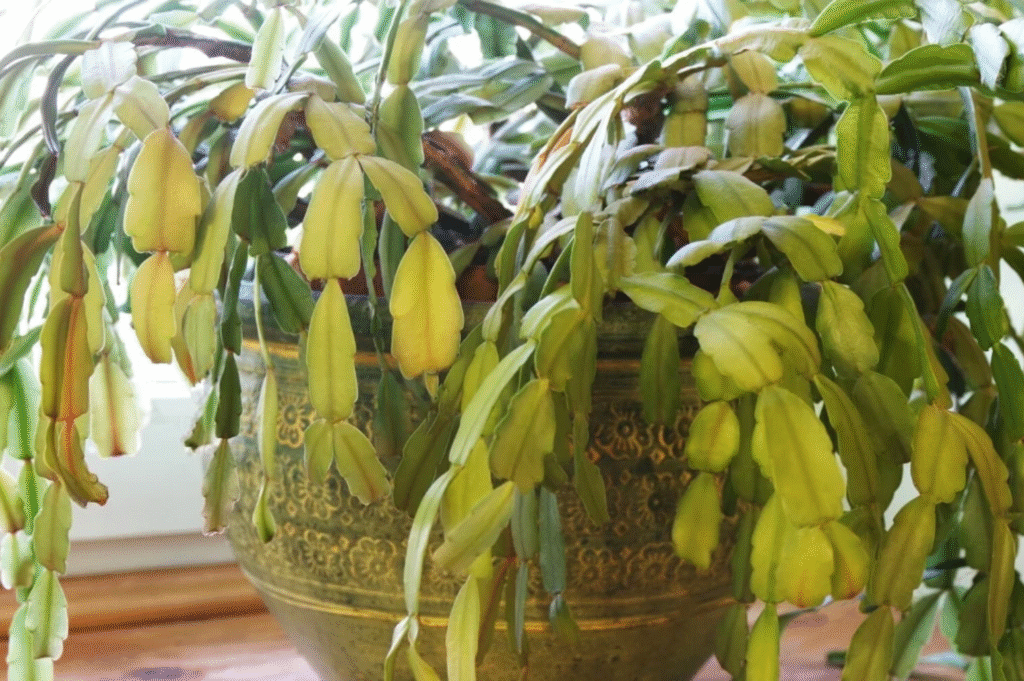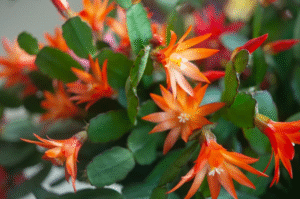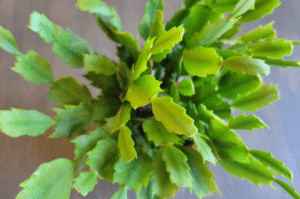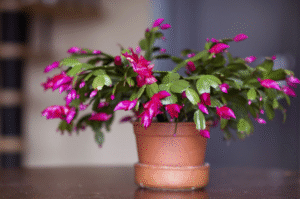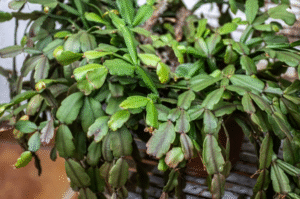The Christmas cactus (Schlumbergera spp.) is a popular indoor plant known for its festive winter blooms and long-lasting beauty. But you’re not alone if you’ve noticed the leaves (or more accurately, the flat stem segments) turning yellow. Yellowing leaves are a common concern for many plant owners and usually indicate that something is off with your cactus’s care routine.
In this guide, we’ll break down the possible reasons your Christmas cactus turns yellow and how to fix the issue quickly and gently.
1. Overwatering – The Most Common Cause
Overwatering is the number one reason for yellow leaves on a Christmas cactus. Unlike desert cacti, the Christmas cactus is a tropical succulent that prefers slightly moist soil, but not soggy.
Signs of Overwatering:
- Yellow, limp, or mushy leaves
- Soil feels constantly wet or has a sour smell
- Roots may start to rot (check for black or mushy roots)
What to Do:
- Allow the top 1–2 inches of soil to dry before watering again
- Make sure your pot has good drainage holes
- Use a well-draining potting mix designed for succulents
2. Underwatering and Dehydration
While overwatering is common, underwatering can also lead to yellowing leaves, especially during warmer months or if the plant is rootbound.
Signs of Underwatering:
- Dry, wrinkled, or yellow leaves
- Soil pulls away from the sides of the pot
- The plant looks limp and weak
What to Do:
- Water thoroughly when the top inch of soil feels dry
- Avoid letting the plant stay completely dry for long periods
- Check if the plant has outgrown its pot
3. Too Much Direct Sunlight
Christmas cacti are native to the shady, humid forests of Brazil. That means they prefer bright but indirect light. Too much direct sun, especially through a window, can stress the plant and cause the leaves to turn yellow or reddish.
What to Do:
- Move your plant to a spot with filtered sunlight or bright, indirect light
- East-facing windows or rooms with sheer curtains work best
4. Nutrient Deficiency
A lack of essential nutrients (especially nitrogen, magnesium, or iron) can cause yellowing leaves. This usually happens if the plant hasn’t been fertilized in a while or the soil is depleted.
What to Do:
- Use a balanced, water-soluble fertilizer (like 10-10-10 or 20-20-20)
- Fertilize every 4-6 weeks during the growing season (spring to early fall)
- Avoid fertilizing during the winter bloom period
5. Root Bound or Poor Soil Conditions
If your Christmas cactus has been in the same pot for years, it may be rootbound, meaning the roots have no more room to grow. This can restrict water and nutrient uptake, causing yellowing.
What to Do:
- Gently remove the plant and check the roots
- Repot into a slightly larger container with fresh, well-draining soil
- Trim back any dead or rotting roots before repotting
6. Temperature Stress
Christmas cacti prefer temperatures between 60°F and 75°F (16°C to 24°C). Exposure to cold drafts, sudden temperature drops, or heat stress can shock the plant, leading to yellow leaves.
What to Do:
- Keep the plant away from heaters, air conditioners, or drafty windows
- Try to maintain a stable indoor temperature
7. Pests or Fungal Issues
Though not as common, pests like spider mites, mealybugs, or fungal infections can damage the plant and cause discoloration.
What to Do:
- Inspect leaves and soil for tiny insects or webbing
- Wipe leaves with a damp cloth and treat with neem oil or insecticidal soap if needed
- Avoid letting moisture sit on the leaves for too long
Final Thoughts
Yellow leaves on a Christmas cactus don’t necessarily mean it’s dying, but they are a sign that something needs attention. By checking the soil, lighting, temperature, and watering routine, you can usually identify the problem and help your plant bounce back.
Key takeaway: Most yellowing issues are caused by overwatering or too much sun. Start there, make small adjustments, and your Christmas cactus will thank you with healthy green growth and beautiful blooms.

